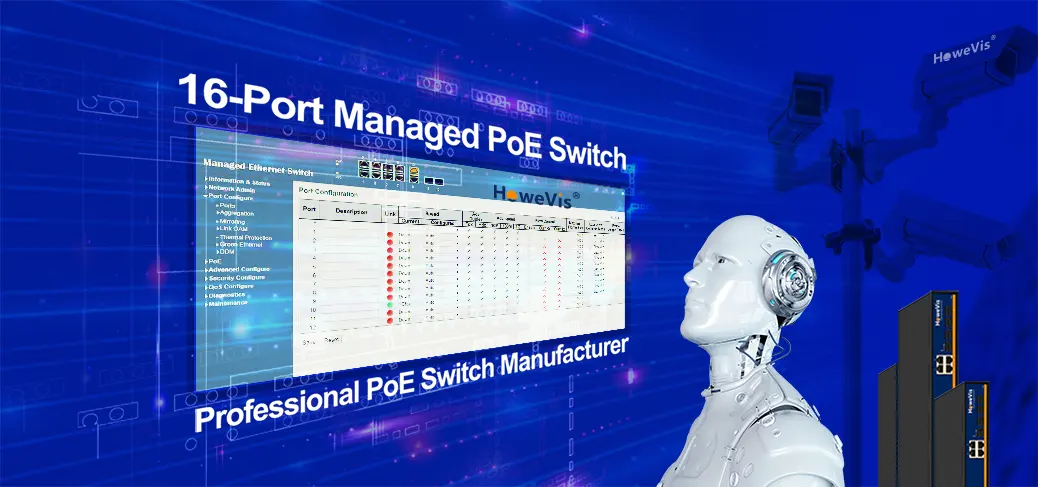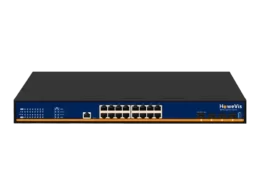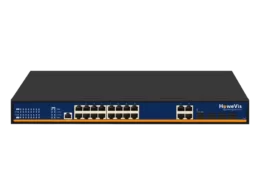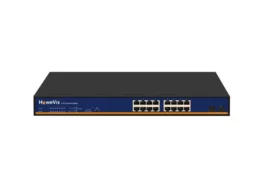We’ve discovered a game-changer in networking technology – the PS51604CM 16-port managed PoE switch. This L2 managed Gigabit Ethernet switch offers unparalleled performance with features like STP, EAPS/ERPS, and IGMP Snooping V1/V2/V3. With IEEE802.3af/at PoE support, this switch can handle a wide operating temperature range from -40 to +75 ℃. Boasting 250W total power and a 3-year warranty, it’s a reliable solution for various networking needs. OEM/ODM options are available, and small minimum order quantities are welcomed, making it accessible to businesses of all sizes.
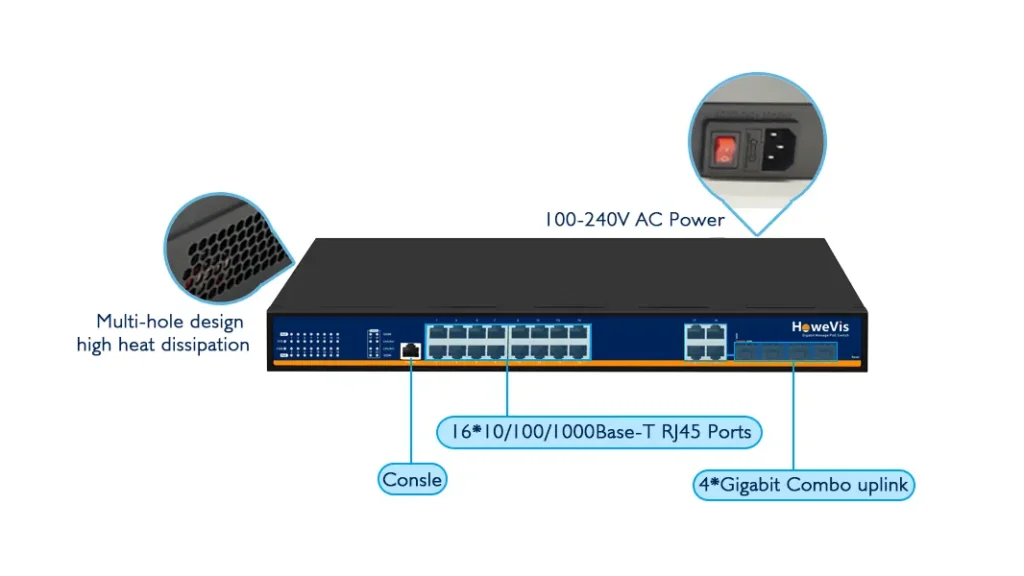
What is a 16-Port Managed PoE Switch
Comprehensive Functionality
Our PS51604CM series offers a robust lineup of Gigabit Layer 2 managed PoE switches, featuring 16 Ports Unmanaged Gigabit Ethernet Switch and 4 Gigabit optical multiplexing ports. Specifically, ports 1-16 support IEEE 802.3af/at standard PoE power supply, delivering up to 30W per port.
Multiple deployment options
These switches are equipped with 4 KV electrostatic lightning protection for service ports. As PoE power supply devices, they are very powerful. They can automatically detect and supply power over the network cable to a variety of devices, such as wireless access points, network cameras, and building visual access control intercoms. This versatility makes them ideal for deployment in hotels, campuses, banks, factories, and small to medium-sized enterprises.
Advanced Network Management Capabilities
The PS51604CM models offer a wide range of L2 network management functionalities. They support IPV4 static route forwarding, comprehensive security protection mechanisms, extensive ACL/QoS policy sets, and a rich array of VLAN functions. They support network redundancy protocols like STP/RSTP/MSTP (<50ms) and ERPS (<20ms) ring network protocols, ensuring link backup and network reliability.
Customizable Configuration Options
Users can configure various applications and services based on specific needs through Web, CLI, SNMP, Telnet, and other network management methods. These include PoE power supply management, port flow control, VLAN segmentation, QoS (Quality of Service), LACP (Link Aggregation Control Protocol), IGMP (Internet Group Management Protocol), DHCP (Dynamic Host Configuration Protocol), and more.
Benefits of Using Managed PoE Switches
Enhanced Network Management Capabilities
When using managed PoE switches, we can enjoy advanced network management features. These switches support automatic learning and updating of MAC addresses, ensuring efficient data transmission. They offer diverse management and maintenance methods like Web-based network management and SNMP, making network monitoring more convenient for us.
Moreover, managed PoE switches prioritize traffic effectively by supporting Quality of Service (QoS) features. With three priority modes based on port 802.1P and DSCP, these switches ensure that critical data gets transmitted without delays. This capability is crucial for us to maintain a seamless network connection during our online gaming sessions or video streaming marathons.
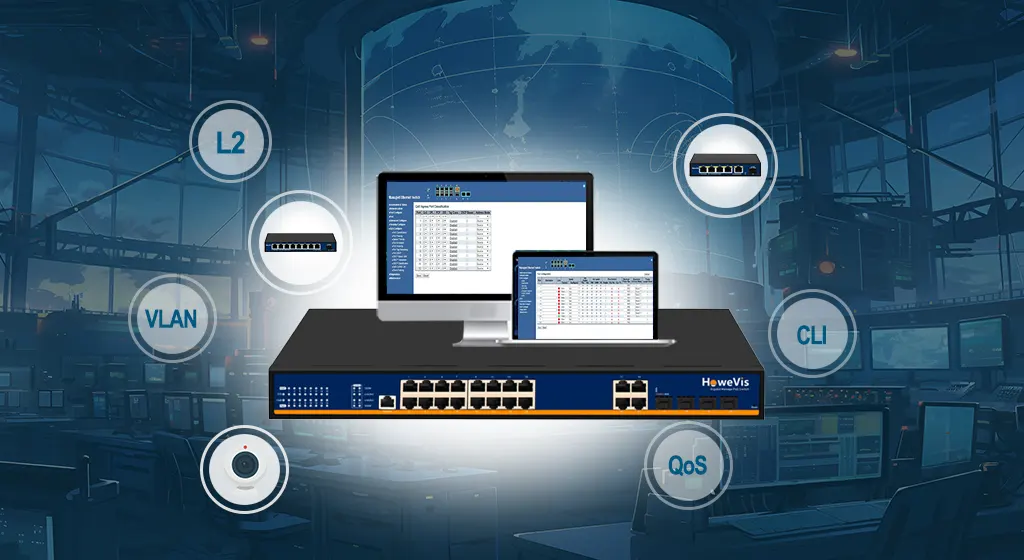
Increased Security Features
Managed PoE switches come with robust security measures that guarantee safe network operations. These switches support Access Control Lists (ACLs), allowing us to configure security policies based on specific rules and time permissions. By implementing packet filtering, managed switches prevent unauthorized access to our network, safeguarding our sensitive data from potential cyber threats.
Furthermore, managed PoE switches enhance security through features like CPU protection and authentication protocols. With support for 802.1x authentication and remote RADIUS/TACACS+ authentication, these switches ensure that only authorized users can access the network. This level of security gives us peace of mind knowing that our network is protected from unauthorized intrusions.
Prioritizing Traffic and Bandwidth Allocation
One of the key advantages of using managed PoE switches is the ability to allocate bandwidth effectively. These switches support flexible port bandwidth configurations, enabling us to adjust bandwidth settings according to our specific requirements. Whether we need high-speed data transmission for large file transfers or consistent bandwidth for VoIP calls, managed switches allow us to tailor our network performance to suit our needs.
managed PoE switches support VLAN configurations and multicast protocols, facilitating efficient traffic segmentation and distribution. By prioritizing critical data streams and optimizing network resources, these switches ensure smooth communication across multiple devices on our network.
Key Features to Look For

PoE Power Budget
When selecting a 16 port managed PoE switch, it is crucial to consider the PoE power budget. This budget determines the total amount of power that can be distributed among all connected devices. Ensuring a sufficient power budget is essential to prevent underpowering devices, which can lead to performance issues.
IEEE Standards Compatibility
IEEE standards play a vital role in the functionality of a managed PoE switch. It is important to choose a switch that complies with IEEE standards such as IEEE 802.3af/at for optimal performance. Compliant switches guarantee compatibility with various PoE devices, ensuring seamless operation within your network.
Uplink Ports for Network Expansion
Uplink ports are essential for network expansion and connectivity in a managed PoE switch setup. These ports enable you to connect additional switches or routers to extend your network reach. Having uplink ports allows for scalability and flexibility in expanding your network infrastructure as needed.
Monitoring and Management Tools
Incorporating monitoring and management tools in a 16 port managed PoE switch is crucial for optimizing performance. These tools provide real-time insights into network traffic, device status, and power usage. By utilizing monitoring and management features, we can efficiently troubleshoot issues, allocate resources effectively, and ensure smooth network operations.
Applications in Different Industries

Surveillance Systems
In surveillance systems, managed PoE switches play a crucial role in facilitating efficient camera deployment. By providing power and data connectivity through a single cable, PoE switches simplify installation processes for cameras in various locations. This streamlined setup reduces the need for additional power outlets and complex wiring configurations, making it ideal for large-scale surveillance deployments.
Moreover, managed PoE switches offer advanced features such as VLAN support and Quality of Service (QoS) settings, allowing users to prioritize video data transmission for smooth and uninterrupted footage streaming. This ensures that critical areas under surveillance receive real-time monitoring without delays or interruptions. Remote management capabilities enable surveillance system administrators to monitor and control camera networks efficiently from a central location.
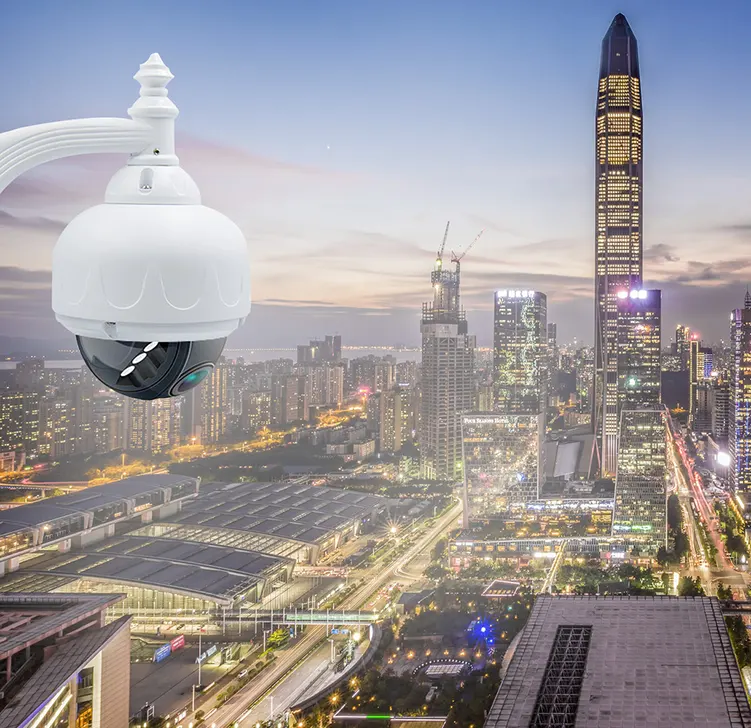
Smart Building Technologies
In the realm of smart building technologies, managed PoE switches play a pivotal role in enabling seamless connectivity for IoT devices. These switches provide power to a wide array of smart devices such as sensors, actuators, and access points, creating a network infrastructure that supports various building automation applications. With the ability to remotely power cycle connected devices, PoE switches offer enhanced control and management capabilities for maintaining optimal performance across the smart building ecosystem.
Furthermore, the integration of managed PoE switches with building management systems allows for centralized monitoring and control of connected devices. This centralized approach enhances overall operational efficiency by providing real-time insights into energy consumption, occupancy patterns, and environmental conditions within the building. By leveraging PoE technology, smart buildings can achieve greater energy savings, improved security measures, and enhanced occupant comfort.

Educational Institutions
In educational institutions, managed PoE switches play a vital role in supporting classroom technology integration. By powering interactive displays, IP cameras, access control systems, and wireless access points, these switches create a robust network infrastructure that enhances teaching and learning experiences. The centralized power delivery and data connectivity offered by PoE switches simplify deployment processes for various educational technologies.
Moreover, the scalability and flexibility of managed PoE switches allow educational institutions to adapt to evolving technological needs within classrooms. As new devices are introduced or existing systems are upgraded, PoE switches enable seamless integration without the hassle of additional power sources or complex cabling setups. This versatility ensures that educators can leverage innovative technologies to create engaging and interactive learning environments for students.
Setting Up Your 16-Port Managed PoE Switch
Connecting Devices
To set up your 16-port managed PoE switch, start by connecting your devices. Use Ethernet cables to link your devices to the switch. Ensure each device is properly connected and powered through the switch.
Once all devices are connected, verify that the power over Ethernet (PoE) feature is delivering power efficiently. This ensures that each connected device receives the necessary power supply for optimal functionality.
Configuring the Switch
Accessing the management interface of your managed PoE switch is crucial for initial configuration. By entering the switch’s IP address into a web browser, you can access the interface. From here, you can customize settings such as VLANs, QoS, and security protocols.
When configuring the switch, prioritize setting up network segmentation. This involves dividing your network into smaller subnetworks to enhance performance and security. By segmenting your network, you can isolate specific groups of devices, improving overall network efficiency and reducing the risk of unauthorized access.
Importance of Network Segmentation
Network segmentation plays a vital role in enhancing both performance and security within your network infrastructure. By creating separate segments for different types of devices or departments, you can control traffic flow more effectively.
Improved Performance: Network segmentation allows you to prioritize critical traffic, ensuring that essential data packets reach their destination without interference. This optimization leads to faster data transfer speeds and reduced latency.
Enhanced Security: Segmenting your network helps contain potential security breaches. In the event of a breach in one segment, other parts of the network remain protected. This isolation prevents threats from spreading across the entire network, safeguarding sensitive information.
Comparing 16-Port and 24-Port PoE Switches
Scalability Benefits
When considering scalability benefits, opting for a 24-port PoE switch offers significant advantages for larger networks. With more ports available, we can effortlessly accommodate additional devices as our network grows. This scalability ensures that our network remains efficient and adaptable to our expanding needs.
Cost Considerations
Cost considerations play a crucial role in deciding between a 16-port and a 24-port PoE switch. While a 16-port switch may be more budget-friendly initially, a 24-port switch provides better value in the long run for scaling networks. By investing in a 24-port switch, we can future-proof our network infrastructure and avoid the need for frequent upgrades.
Space Requirements and Installation Flexibility
When it comes to space requirements and installation flexibility, a 24-port PoE switch may seem bulkier compared to a 16-port model. However, the additional ports offer versatility in setting up our network infrastructure. Despite requiring more physical space, a 24-port switch allows us to connect more devices directly without the need for additional switches or complex cabling setups.
Our experiences with networking equipment have taught us the importance of considering scalability, cost-effectiveness, and practicality when choosing between different switch models. By weighing these factors carefully, we can ensure that our network setup meets both our current requirements and future expansion plans effectively.
Tips for Maintaining Your PoE Switch
Firmware Updates
Regular firmware updates are essential to enhance performance and security of your PoE switch. By keeping the firmware up-to-date, we ensure that the switch operates efficiently and is protected from potential vulnerabilities.
It is crucial to check the manufacturer’s website for any available updates and follow their instructions carefully. Firmware updates typically address bugs, improve functionality, and strengthen security measures, making them a vital aspect of maintaining a healthy PoE switch.
Monitoring Power Consumption
Monitoring power consumption is key to preventing overload issues in your PoE switch. By keeping track of the power usage of connected devices, we can ensure that the total PoE budget is not exceeded, leading to stable and uninterrupted operation.
We should regularly assess the power requirements of PoE devices connected to the switch and adjust settings accordingly. By staying within the total PoE budget, we avoid potential power failures and maintain a reliable network infrastructure.
Routine Inspections
Routine inspections of physical connections and environmental conditions are necessary to keep your PoE switch in optimal condition. We need to visually inspect cables, ports, and connections for any signs of wear or damage, ensuring proper functionality.
Moreover, assessing the environmental conditions such as temperature and humidity levels around the PoE switch can help us identify potential risks that may affect its performance. By conducting regular inspections, we can address any issues promptly and prevent downtime.
Troubleshooting Common Issues
Connectivity Problems
We may encounter connectivity issues with our 16-port managed PoE switch due to various reasons. Loose cables, incorrect configurations, or faulty hardware can lead to network disruptions. To troubleshoot, check cable connections, verify settings, and inspect for any damaged components.
Diagnosing Power Delivery
When facing power delivery issues to connected devices, it is essential to determine the root cause promptly. Start by examining the power source, ensuring proper wattage allocation, and testing different ports for functionality. Rebooting the switch can also resolve temporary power-related glitches.
Resolving Network Performance Lags
Network performance lags and packet loss can significantly impact operations. To address this, analyze network traffic using monitoring tools to identify congestion points or bandwidth limitations. Implement Quality of Service (QoS) settings to prioritize critical data and optimize network efficiency.
Final Remarks
Our journey through the realm of 16-port managed PoE switches has been enlightening. We’ve uncovered the essence of these devices, delved into their benefits and key features, explored diverse applications in various industries, and even mastered the setup and maintenance tips. Comparing 16-port to 24-port switches has broadened our understanding, equipping us with troubleshooting skills for any hiccups along the way. Now, armed with this knowledge, let’s venture forth and harness the power of managed PoE switches to elevate our networks to new heights. Let’s optimize our setups, troubleshoot like pros, and embrace the efficiency and convenience these devices offer. Our networks await – let’s make them robust and reliable!
Frequently Asked Questions
What is a PoE switch?
A PoE switch is a network switch that integrates Power over Ethernet technology, allowing both data and power to be transmitted over a single Ethernet cable. This eliminates the need for separate power sources for connected devices.
How does a 16-port managed PoE switch differ from an unmanaged one?
A managed PoE switch offers advanced features like VLAN configuration, QoS settings, and remote management capabilities, providing greater control and flexibility. In contrast, an unmanaged switch operates with fixed settings and no customization options.
Can I use a 16-port managed PoE switch in my small business?
Yes, a 16-port managed PoE switch is suitable for small to medium-sized businesses looking to efficiently power and manage multiple network devices. Its features enhance network performance, security, and scalability, making it a valuable investment.
What are some common applications of a 16-port managed PoE switch?
These switches are commonly used in various industries such as offices, schools, healthcare facilities, retail stores, and surveillance systems. They power devices like IP cameras, VoIP phones, wireless access points, and IoT devices while providing network management capabilities.
How do I troubleshoot common issues with a 16-port managed PoE switch?
When facing issues like connectivity problems or power delivery issues, start by checking cable connections, rebooting the switch, and verifying configurations. Utilize the switch’s management interface for diagnostics and seek assistance from technical support if needed.
